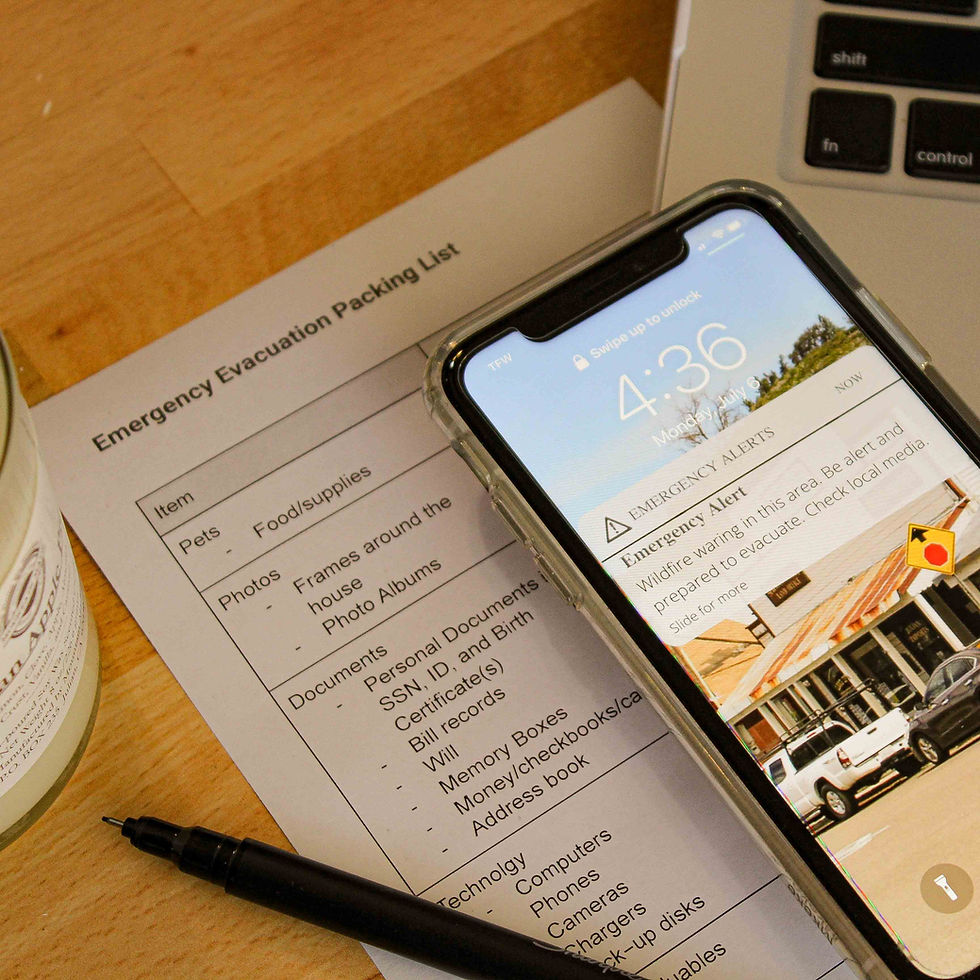Preparing to Evacuate
- Eva Hatch

- Aug 19, 2020
- 3 min read
Updated: Dec 29, 2020

During the early half of my childhood, my family had to evacuate multiple times due to wildfires. The San Diego backcountry has many scars from wildfires that have torched the landscape. In recent years, the frequency of fires has diminished. This doesn’t mean we are out of the woods. If anything, it means an increased chance of a larger fire. Being ready to evacuate begins long before the threat is there.
When it comes to evacuating, you may have only minutes to hours to prepare. This makes preparation a critical and continual process. The first step begins with making sure your home has the best chance of withstanding a fire. Ensuring that your house and landscape are fire-resistant minimizes fire damage when your home is on its own and when firefighters are there battling the blaze. For more information on how you can prep your property for wildfires, check out my blog post.
Today we are going to discuss what to do when a wildfire threat is present. Contrary to popular belief, based on my personal experience with wildfires in the San Diego backcountry, warning of an emergency tends to come from neighbors instead of government officials who need a bit of time to coordinate a public notification. Therefore, you must always be on the lookout for signs of a wildfire. Do not wait for an evacuation order to leave. If it's unsafe, evacuate. The actions you take prior to evacuation depend completely on the amount of time you have.
Before the threat:
Prepare your home and landscaping to be naturally fire-resistant.
Take photos or videos of your property and valuables and upload it to a cloud location. If any of your property is lost in an emergency, this will become documentation to show your insurance company. I recommend taking a new video every year just before the fire season.
Create an emergency evacuation packing list. In an emergency, it’s easy to forget the simplest, most obvious things. Make a prioritized list of items to grab and their locations. Whether it’s you or a good Samaritan grabbing your items, this will help tremendously in the moment.
Store important items in labeled drawers or plastic bins that can easily be seen and moved.
Have a bug-out bag(s) ready to go. This is a bag with clothes and personal care items stored by your door or in your car, ready to be used in the event of an emergency.
Prior to leaving for an extended period of time, leave important documents near your front door. In the event that a good Samaritan or firefighter comes by, this makes it easy for them to grab items for you.
Learn all possible evaluation paths. I recommend driving them prior to an emergency, increasing your comfort and knowledge of your whereabouts.
Stay “gassed up”—keep enough gas in your car so you can evacuate.
When there’s a threat:
1. NEVER put property over life.
You can always replace physical items, but human life is irreplaceable. Always make sure you, loved ones, and pets are out of danger. This includes notifying your neighbors of a fire. Do the following as long as it is safe to do so.
2. Grabbing valuables
Back your car into the driveway and leave your keys in the ignition. Begin to pack items from your emergency evacuation packing list. Pack your car with what is most important to you first. See my list here.
3. Final preparations - Do only what you have time for.
Leave gates open and doors unlocked for first responders.
Wear sturdy shoes and clothing that provides some protection such as long pants, long-sleeved shirts, and a hat.
Disconnect any automatic garage door openers so that doors can still be opened by hand if the power goes out.
Close all doors, windows, and vents in your home.
Move flammable items away from windows on both the inside and outside of your home.
Close non-combustible window coverings.
Turn off all gas sources into your home.
Unplug electrical equipment. Leave freezers and refrigerators plugged in.
Connect hoses and fill bathroom tubs, garbage cans, or other large containers with water. Place the filled containers around the house. Don’t leave sprinklers on or water running; they can affect critical water pressure.
Place ladders, hoses, and tools in clear view.
Turn on all outside lights.
When leaving a car(s) behind LEAVE THE KEYS IN THE IGNITION and the CAR DOORS UNLOCKED. This will allow first responders to move your cars in case they have to open up the area for better access for equipment and/or fire trucks.
If time permits, use outside hoses to spray down the house, siding, decks, and roof.
4.Leaving
Evacuate via the safest route. Roll up windows and close air vents. Drive safely with headlights on.




Comments